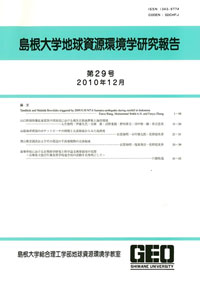島根大学総合理工学部地球資源環境学教室
ISSN:1343-9774

ダウンロード数 : ? 件
この文献の参照には次のURLをご利用ください : https://ir.lib.shimane-u.ac.jp/31119
島根大学地球資源環境学研究報告 30
2011-12-27 発行
Geochemical analysis of heavy metals in soils of the Yamasaki archaeological site, Hikimi River, Masuda, Japan
ダライ バンズラグシュ
ファイル
内容記述(抄録等)
Geochemical study of soils was carried out at the Yamasaki archaeological site in Masuda city for evaluation of human activities during the earliest to late Jomon age. Abundances of P2O5, Cu, Zn, I, TS (total sulfur), Sr, Br and F show variations in vertical profiles in four trenches. These elements are good indicators of habitation sites and pottery manufacture. In contrast, concentrations of TiO2, Fe2O3, MnO, CaO, As, Pb, Ni, Cr, V, Nb, Zr, Y, Th and Sc show no significant change in the profiles. This may be related to provenance of the area, and indicates lack of active metal production or smelting.13;
Other Article
PP. 25 - 30
PP. 65 - 72
PP. 73 - 81
